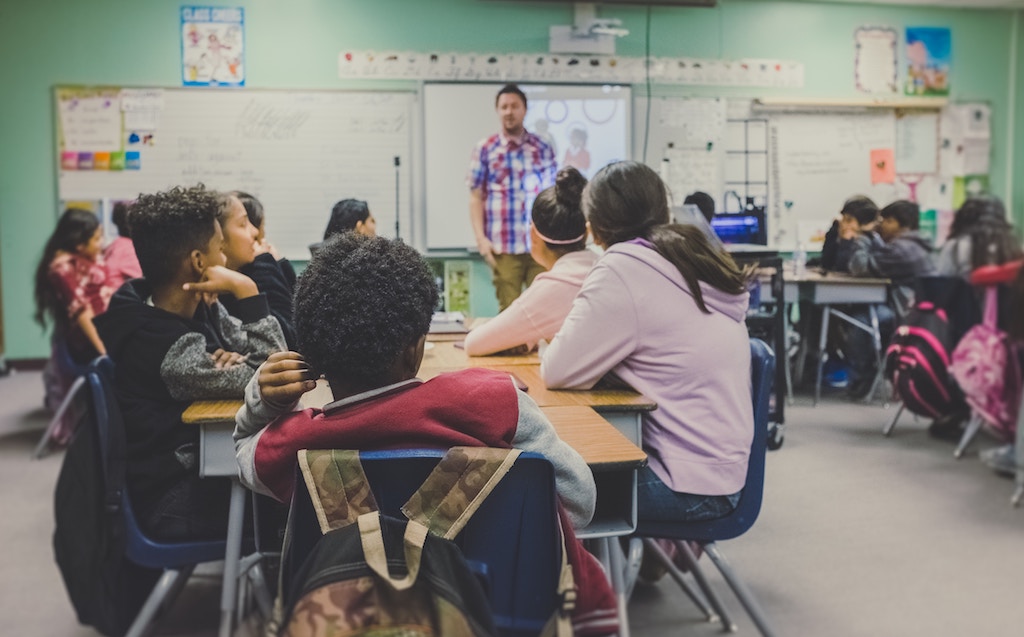by Robert Rue —
It sometimes seems that “student-centered learning” is everywhere. Countless schools around the country—public and private, non-profit and for-profit—use this term, or its cousins (“deeper learning,” “inquiry-based learning,” “project-based learning,” “learning by doing,” etc.), to describe what happens in their classrooms and on their field trips. Websites and glossy brochures tell us that the age of passive learning and “drill and kill” pedagogy is over. These schools—sometimes self-described as “progressive” and often not—talk of projects and problem solving, student-voice and autonomy. They tell us that the needs and questions of kids drive the curriculum. With this model of school, students are engaged and curious. They retain more of what they learn, and they want to learn more.
I’m all for it. I’ve seen it work. And I wish student-centered learning actually were everywhere.
But I also know that achieving the deeper learning that these approaches tout is not so simple.
As powerful as student agency can be, helping young people reach the goal of independent, rigorous, creative inquiry is not just a matter of giving them freedom. This oversimplified idea is unfortunately perpetuated by PR articles about student-centered learning that tell astounding stories of engagement, innovation and initiative without even mentioning the teacher—as if, once students are empowered, their natural curiosity will propel them to all the learning anyone could hope for.
Student-centered learning can be transformative. In my career in high schools, I’ve been lucky enough to observe teaching colleagues who knew how to create, through a careful modulation of pedagogical approaches, a rich and authentic learning environment.
But if leadership is not careful “student-centered” principles can become distorted, and a whole host of myths and bad practices can take root:
If the autonomy of the child is good, then the authority of the teacher is bad.
If active inquiry is exciting, then lecturing and demonstrating are soul-crushing.
If student voice is the value, then anything that gets kids talking is admirable.
If field trips are mind-expanding, then classroom activities are mind-numbing.
If their needs and questions should shape the curriculum, then anything students don’t immediately embrace is suspect.
Rarely will adults in student-centered schools say the things I’ve listed above, and no serious educational theorist supports such ideas—at least not in the stark form I’ve stated them. When these beliefs exist in schools, they are implicit—in what they praise and what they critique and more subtly in what they stay silent about. There can arise in student-centered schools a sense among the faculty that, if their students are not at every moment engaged in an activity that would gleam on the pages of the school’s admissions materials, the teaching mission is not being achieved. When there is a conflict between a student and a teacher, one can sense the default conviction (the key word is default) in the room of student-centered educators discussing it that an adult’s use of authority—an incursion on the natural state of the child—is somehow to blame.
Richard Hofstadter, in his 1964 Pulitzer Prize-winning book Anti-Intellectualism in American Life brilliantly unpacks the historical circumstances that gave rise to this romantic vision of the nature of children and the thought-provoking but problematic educational philosophies espoused by theorists and practitioners like G. Stanley Hall, Francis Parker, John Dewey and Maria Montessori. He wrote of the “penumbra of sanctity with which the figure of the child was surrounded” in the schools that sought to move away from conventional authoritarian pedagogy. The assumption at these “progressive” schools seemed to be that children were perfect and that all a school needed to do was avoid choking off students’ natural proclivities. I’m with Hofstadter who believed that the placing of children on a metaphorical pedestal in some American schools resulted from both understanding and misunderstanding what these theorists actually said, but that’s another article—or better yet, you should read the Hofstadter.
In any case, the legacy of the sanctified child is with us. “Let the child’s nature fulfill its own destiny,” Dewey once wrote. And there is something to be said for this nature. Most very young children are learning machines—budding scientists—as they experiment with, hypothesize about and literally bump up against the world outside of their mothers’ wombs. But the words “let” and “destiny” in Dewey’s sentence are worthy of serious analysis, discussion and debate among educators. I would argue that these words—and many like them in his work—have had their own confused and confusing legacy. Can schools really just “let” their students find their education? Do the natures of children really have “destinies”?
I don’t think so.
Some proponents of student-centered education, whom I count as my allies, will glare at me suspiciously and reflexively claim that I am assembling a straw man to knock down—the idea that progressive schools are too loosey goosey—and that in doing so, I am aiding and abetting the conventionalists. No good progressive school, they say, indulges in the oversimplifying of the child that I’m suggesting here. (I’ve read and respected your work, Mr. Kohn.) But I must insist that I’ve seen and heard nearly incontrovertible evidence of its existence.
Once, when visiting a student-centered school, I sat in on a class that the head of school was also observing. Before the class began, the teacher leaned over to the head and offered to show her boss the syllabus and the assignment the students were working on, to which the head of school replied, “No thanks. I just want to hear what the kids have to say.” It was as if the crafting of a course and the articulation of an assignment had no bearing upon the education of the students. The teacher stood and wandered away in confusion, annoyance and humiliation. I have also witnessed projects and courses that were so open-ended that even when the students used their freedom to avoid every possible serious engagement with the material—or any material—the teacher stood piously by respecting the students’ independence.
By the time children arrive in school, particularly in the older grades, they bring with them not just their natural curiosity—if it has survived— and their many admirably achieved understandings of the world. They also bring their erroneous beliefs, their half-understandings, their self-protective mechanisms, their prejudices and their outright fallacious ideas. Whatever might be said for the sanctity of a child’s original state of curiosity and commitment to learning, one cannot say that this condition remains uncorrupted for long. In fact, I would argue that the intellectual destiny of most human beings thrusts far more toward comfortable, self-serving, socially convenient notions of the world than it does toward educated ones.
This is why schools must not—explicitly or implicitly—construct themselves on a foundation of irrational faith in a child’s tendency to learn. Neither, I rush to add, should they force kids onto an assembly line of short-term memory exercises and standardized test prep.
What schools ought to do is “teach for thinking.” This is not to be accomplished by downloading our wisdom into students and then testing to see if they’ve retained it. The freedom to explore and question and construct is essential. But teaching for thinking absolutely requires some adult-interventions that could not possibly be construed as mere “letting.”
Student-centered or teacher-centered? It’s a false choice.
So how does a teacher operate in a great high school course?
The great teachers I’ve observed have as their central goal not the downloading of information but the teaching of independent, rigorous, creative thinking.
In order to “teach for thinking” these high school instructors:
- Put students in position to discover ideas.
- Engage in a flexible cycle of teacher- and student-centered work.
- Have a method for evaluating not just what students produce but the way they go about producing it. (See “What Are We Grading?”)
Discovering
This is the essence of an exciting learning experience. In such a course, everything the teacher does, everything the students do, is designed to make likely the discovery of, as opposed to the receiving of, ideas. One way to accomplish this is to foreground work with intriguing questions. Before teaching the Pythagorean theorem, I once saw a teacher put a bunch of right triangles of varying size on the board and ask students if they could detect any patterns in their proportions. Before quizzing students on what Article I, section 8 of the U.S. Constitution says, one teacher asked students how democratic the document as a whole is. Before teaching the theory of evolution, a great biology teacher asked, If we went back to the moment of life’s inception on Earth and set time in motion again, would humans wind up dominating the planet once more?
Whatever the topic of study, great teachers I’ve observed ask students what questions they have. If we do this , we may hear a gem of a question, the exploration of which will lead to great discovery. Use it! Help the students—or just that one student—design an assignment around it. Or we may just learn at the beginning of a unit exactly what our students understand and misunderstand.
And regardless of whether or not our students can replicate the thinking of Pythagoras or of Darwin, regardless of whether or not they can arrive at a fully sophisticated theory of the Constitution before we’ve pored over it together, imagine how much more fertile our teaching will be if the students have tried to solve a puzzle before they’re told what to know. When we get them thinking first, we get meaningful questions from the students: “Wait, why did you only put right triangles on the board?” they might ask. “Isn’t evolution like a machine?” “Hey, what’s the definition of ‘democratic’?”
And we’re off. The difference between a course that begins with questions—ours and our students’—and a course that begins with the downloading of information into our students’ brains—is the difference between lightning in a bottle and a lightning bug in a bottle.
Once students are intrigued, maybe even fired up—their questions are kindling—great teachers proceed toward what should be central in a course: some authentic doing of the discipline being studied. A mock Supreme Court case in a constitutional law course, a test for the ingredients in a mysterious solution in a chemistry class, a publication of essays about the novel being read in English. You get the idea.
The Cycle of Student- and Teacher-centered Work
But in order for students to discover ideas while they are engaging in authentic doing, they probably need to have some knowledge that they don’t already have. They need to have some skills. If there’s no efficient student-centered way of kids gaining the knowledge and skills they’ll need to do the authentic activity the highly effective teachers I’ve seen deliver the necessary information. But that delivery of information seems so much more relevant to students when they know that it will enable them to enact a court case or solve a chemical mystery. Students who have been intrigued by some essential questions in a course, and who understand that certain information and skills will help them perform a task that seems inherently meaningful, are likely to be invested in learning things that might otherwise seem arbitrary and useless.
As a great teacher moves through a course that has an authentic act of doing—or many—at its core, the teacher may need to keep returning to teacher-centered work. Flexibility is essential. One year, the teacher will need to stop the class and deliver a brief lecture about the presumption of innocence in American law. The next year she won’t need to. One year, he’ll have to engineer a discussion about civility in exchanging ideas. Another year he won’t. Such “teacher-centered” work is, in fact, student-centered.
And while students are engaging in their authentic doing, a great teacher is keenly observing them, ever on the alert for the moment when some kind of teacher-intervention is necessary.
Evaluating Process
Highly effective teachers also keenly observe and evaluate the way in which students go about their work. The best teachers know that the evaluation of results—tests, papers, quizzes, etc.—is, by itself, not a reliable enough indicator of a student’s learning. Results on conventional assessments can be faked—by memorizing things one doesn’t understand, robotically imitating processes, sussing out what the teacher wants, or by outright cheating. To avoid this anti-learning dynamic, great teachers name and evaluate behaviors that reliably lead to genuine learning—things like consistency of engagement, the ability to self-assess and revise, to take intellectual risks, to build ideas collaboratively, to meet deadlines or to reasonably negotiate new ones, etc. And of course, effective teachers also grade products—the more authentic and unfakeable the better.
A school philosophy is nothing to be sneezed at. We do need ways of succinctly and clearly conveying to our potential families what it is that we do. But it is equally important for one-dimensional admissions rhetoric not to become the actual measuring stick for the educational program. Great teachers can’t afford to be one-dimensional. They must instead be masters of the oxymoronic: of planning and flexibility; direction and openness; of course material and of the students’ construction of it; of student- and teacher-centered pedagogy.






